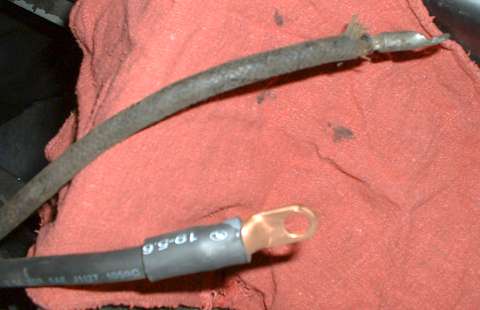The MGA With An Attitude
LARGER BATTERY CABLES For MGA - SS-103A
Why Bother?

If your battery(ies) is(are) in good condition and all connectors are clean and tight, the standard size cables do okay, and the current will spin the starter over well even in cold weather. Modern batteries (at leaset 12 volt batteries) have considerably higher Cold Cranking Current capacity than the original twin 6 volt batteries. The higher CCA current means less internal resistance for less voltage loss inside the battery and better current for faster cranking. If the battery is a little weak or you drive in extremely cold weather, you may benefit by using larger cables for slightly stronger current. You could use larger welding cable (1 AWG or 0 AWG) which is more flexible and carries more amperage with less voltage drop (making the starter spin faster). But don't get too carried away with the idea of switching to monster battery cables just yet.
The main battery cable is about 8 feet long. 1 AWG copper wire has resistance of 0.124 ohms/1000ft, or .000124 ohms/ft. For the 8 ft long cable this works out to a total of 0.001 ohm. All of the shorter cables combined are about 4 feet long. 4 AWG copper wire has resistance of 0.2485 ohms/1000ft, or 0.000245 ohms per foot. For the 4 ft length of smaller cables this works out to a total of 0.001 ohm. I will venture a reasonable guess that the large steel chassis frame between engine ground and battery ground points may be equal to about 2 feet of 4 AWG copper wire, or 0.0005 ohm resistance. Adding cables and chassis resistance together gives a total of 0.0025 ohm for all of the main conductors.
Rule of thumb indicates that cranking the engine with the starter motor may require about 1 amp (at 12 volts) for each cubic inch of engine displacement. The (current) engine in my MGA is 1625cc, or 99 cubic inches, so it should take about 100 amps to crank it over. Let's suppose a strong battery may give it 200 amps during hard cranking in cold weather. Using Ohm's Law (E=IR), 200 amps going through a 0.0025 ohm resistor will have a voltage drop of 0.5 volt. This would be 0.2 volt on the main cable, 0.2 volt on the smaller cables, and 0.1 volt through the steel frame.
To put things into proper perspective, changing all of the smaller battery cables from 4 AWG to 1 AWG would cut the resistance there in half and reduce the voltage drop by half, recovering all of 0.1 volt to be added to the starter cranking input. If you increase all of the cables to 0 AWG you could cut the cable resistance by another 20%, which would recover another 0.06 volt. All together this could give you an additional 1/16 of a volt for the starter motor, on top of 9 or 10 volts it may see during cold cranking.
So now I can ask, is this really worth the effort to change out all of the battery cables for such little gain? Apparently there is a point of diminishing returns where big enough really is big enough. If you have a slow cranking problem in cold weather, perhaps you should be looking elsewhere for the cause of low voltage at the starter motor. Check the condition of the battery first. Then check, clean and tighten all of the cable connections to avoid any high resistance contacts. Also check for voltage drop across the starter switch with full cranking current. Happy hunting.
Addendum: Follow-up to main battery cable size.
At 09:56 AM 10/19/2006 -0600, Randy Brown wrote:
"I have Questions about the accuracy of the battery cable page on your website. Where did the size information come from? My measurement of original cables show them to be 2 gauge not 1 gauge."
Considering the frugalness of the MG factory system, I would have been inclined to believe that the main battery cable would have been 2 AWG, figuring that it would be marginally good enough to perform the function. I would be tickled pink if there was factory documentation somewhere showing the original construction of these cables.
My note about 1 AWG main cable comes from measuring the one in my car. I have measured the conductor a few different directions at both ends near the end terminals. No matter how hard I try to convince myself it should be smaller, it keeps coming out .300-.310 with my dial caliper. I might concede some problem measuring over the outside of the radius of the outermost strands, so maybe it's only .295, but no way could it possibly be anywhere near as small as .250. It is definitely 1 AWG.
I bought this cable from the parts counter at an MG dealer in late 1977 as part of the first parts order when I began restoring my car (the first time). It was OEM replacement part with a factory part number tag. I would be hard pressed to believe that the factory would have paid the bill to fabricate these replacement parts in mass production with larger wire size than was intended (on the assumption that the original size should have been 2 AWG). While I concede this is not the cable that came in the car from original production, it is a standard OEM factory replacement part, which I will assume is true to original form until someone may produce proof to the contrary.
I have spent hours searching the internet for any well founded information on original cable size for these cars, but so far all for naught. I suspect in the end the closest we can get to the truth is measurement of enough verified original production parts for reasonable statistical analysis. Certainly the parts from any single car cannot prove that 100,000 others should be the same.
|